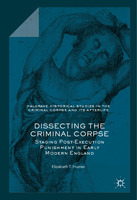Dissecting the Criminal Corpse
Staging Post-Execution Punishment in Early Modern England
Author(s)
T. Hurren, Elizabeth
Collection
WellcomeLanguage
EnglishAbstract
Those convicted of homicide were hanged on the public gallows before being dissected under the Murder Act in Georgian England. Yet, from 1752, whether criminals actually died on the hanging tree or in the dissection room remained a medical mystery in early modern society. Dissecting the Criminal Corpse takes issue with the historical cliché of corpses dangling from the hangman’s rope in crime studies. Some convicted murderers did survive execution in early modern England. Establishing medical death in the heart-lungs-brain was a physical enigma. Criminals had large bull-necks, strong willpowers, and hearty survival instincts. Extreme hypothermia often disguised coma in a prisoner hanged in the winter cold. The youngest and fittest were capable of reviving on the dissection table. Many died under the lancet. Capital legislation disguised a complex medical choreography that surgeons staged. They broke the Hippocratic Oath by executing the Dangerous Dead across England from 1752 until 1832.
Keywords
georgian england; convicts; murderers; homicide; early modern england; murder act; crime studies; Anatomy; Autopsy; Capital punishment; Dissection; Gallows; Hanging; London; Surgeons' Hall; SurgeryDOI
10.1057/978-1-137-58249-2ISBN
9781137582485OCN
967626082Publisher
Springer NaturePublisher website
https://www.springernature.com/gp/products/booksPublication date and place
Basingstoke, 2016Grantor
Imprint
Palgrave MacmillanSeries
Palgrave Historical Studies in the Criminal Corpse and its Afterlife,Classification
European history
Social and cultural history
History of science
Pages
326Chapters in this book
- Chapter Bibliography
- Chapter PART II: PREAMBLE
- Chapter 4 Delivering Post-Mortem Harm: Cutting the Corpse
- Chapter 1 The Condemned Body Leaving the Courtroom
- Chapter Preface
- Chapter 3 In Bad Shape: Sensing the Criminal Corpse
- Chapter PART I: Introduction
- Chapter Abbreviations
- Chapter 6 The Disappearing Body: Dissection to the Extremities
- Chapter 2 Becoming Really Dead: Dying by Degrees
- Chapter 5 Mapping Punishment: Provincial Places to Dissect
- Chapter 7 He that Hath an Ill-Name Is Half-Hanged: The Anatomical Legacy of the Criminal Corpse


 Download
Download Web Shop
Web Shop